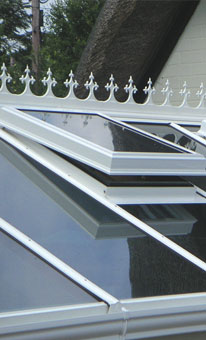Conservatory Roofs & Roof Finishes
 The appearance of the conservatory roof is an important issue for many people and if your conservatory is a major investment, don’t penny-pinch by installing a cheap one. This is especially important if you want to use your conservatory all year round, in which case you should specify glass as the conservatory roofing material along with appropriate heating and ventilation.
The appearance of the conservatory roof is an important issue for many people and if your conservatory is a major investment, don’t penny-pinch by installing a cheap one. This is especially important if you want to use your conservatory all year round, in which case you should specify glass as the conservatory roofing material along with appropriate heating and ventilation.
A glass conservatory roof is heavy and the structure of the roof beams need to be strong enough to support the weight of glass especially if it is double or triple glazed.
Polycarbonate conservatory roofing is a lighter alternative but not as aesthetically pleasing as glass, and can be very noisy to be under when it rains.
If your conservatory is overlooked, a tiled roof, or a flat lead roof will protect you from prying eyes.
Crestings and Finials are the decorative architectural flourishes seen on the roof of a conservatory that give it the finishing touch.
Glass Conservatory Roofs
Glass is the natural choice for a conservatory roof, looks good when installed and if properly cared for will give years of pleasure. If you haven’t already done so, take time to read our page on Glass Types to find out more about U-Values, Heat Reflective Glass and Self Cleaning Glass.
Polycarbonate Conservatory Roofs
Polycarbonate is light and strong and is resistant to shattering. It is available in a range of different thicknesses and finishes with better U-Values the thicker it becomes. 16mm polycarbonate is the lowest thickness that should be specified with a U-Value of around 2.6, however, a conservatory with a roof like this will be cold in the winter and uncomfortably hot in the summer, leaving you a place to enjoy in Spring and Autumn only!
25mm and 35mm polycarbonate have U-Values of around 1.6 and 1.5 respectively, provide better insulation and are the standard polycarbonates in use today. These thicker polycarbonates also provide greater sound insulation from traffic noise and the beating of rain on the roof.
Polycarbonate conservatory roofing is available in a wide range of tints that will help reduce glare and provide some shading.
Ask your designer or builder to show you samples so you can choose which will be the most suitable for your conservatory. But note that even the clearest polycarbonate will not be as transparent as glass and a clear polycarbonate might not be suitable for a south-facing conservatory in the summer months.
Tiled Conservatory Roofs
A sunroom or garden room with a tiled roof can often blend in more easily with a traditional home than a traditional conservatory. If you have a north-facing conservatory the extra insulation will provide you with a room that will be more economical to heat in the winter and if south-facing, you will not have problems with the room overheating on blazingly hot summer days. If your conservatory is overlooked, a tiled roof conservatory will also protect you from prying eyes.
Lead Conservatory Roofs
A flat roof finished in lead, is typically found on an orangery rather than a conservatory, but sometimes you may have to specify a conservatory with a flat roof. For example, there may be an issue about access to or from upper windows, with Building Regulations requiring you to ensure that a conservatory is not constructed in a manner that restricts ladder access to windows serving a room in a roof or loft conversion which are required for means of escape purposes.
If the conservatory is below windows, you may prefer it not to be seen from them and a lead roof will provide an attractive finish that will not be an eyesore. Alternatively, zinc or copper can be used as the roofing material and like lead, they mellow to a beautiful patina, but add substantially to the final cost. So for most installations we recommend that you choose a synthetic weatherproof material with a long guarantee.
Crestings & Finials
Crestings and Finials are the decorative architectural devices seen on the roof of a conservatory. The finial is the pointed feature at the front of the apex and the cresting is the piece running along the ridge of the roof. These features usually sit on the roof capping.
The finial also used to function as a lightning rod and has simply become an architectural flourish over time. As an ornamental item the finial can be made from a solid piece of wood to match the wood used in your conservatory, or purchased as an off-the-shelf item cast in aluminium or moulded plastic.
Crestings, like finials are made either from cast aluminium or moulded plastic. The aluminium varieties are often finished with a polyester powder coating and this leaves a resilient surface finish that can often be guaranteed for up to 10 years depending on the price you are prepared to pay and the supplier.
The moulded plastic variety can look equally good and may save you some money. Both types are available in a variety of colours to match the exterior paintwork of your conservatory.
Traditional conservatories based on Georgian, Victorian or Edwardian designs normally include crestings and finials on their roofs, but if you have a modern conservatory you can dispense with them or use a minimalist cresting as a finishing touch.


